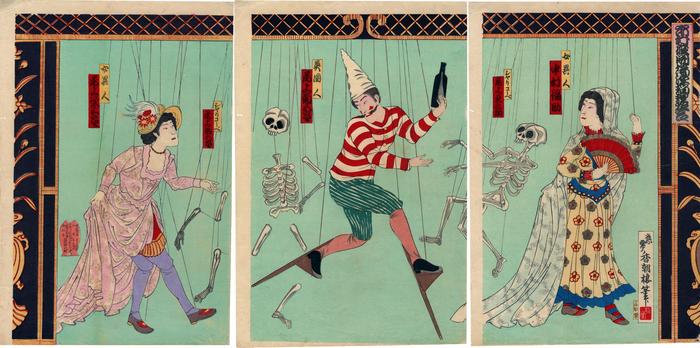Utagawa Kunisada III (三代目歌川国貞) (artist 1848 – 1920)
Kyōgen jōruri opening - Nakamura Fukusuke IV (中村福助), the woman on the far right - Onoe Ushinosuke II (尾上丑之助) is the skeleton next to her - Onoe Kikugorō V (尾上菊五郎) is the man on stilts - Onoe Eizaburō V (尾上栄三郎) is the woman in the pink dress on the left
1893
30.25 in x 15 in (Overall dimensions) Japanese color woodblock prints
Signed: ōju Kōchōrō hitsu
應需香朝楼筆
Publisher: Fukuda Kumajirō
Carver: Watanabe Tsunejirō
Date: 明治廿六年
Harvard Art Museums
Japan Arts Council
Waseda University - right panel
Hagi Uragami Museum of Art
National Library of Australia
Achenbach Foundation for Graphic Arts
Lyon Collection - 18th century Shun'ei print of an actor with a puppet
Lyon Collection - 1954 Sekino print of puppeteer and puppet
Edo-Tokyo Museum At first glance this triptych might seem a bit jarring to us, even amusing, because it is not at all what we have come to expect from a more traditional Japanese woodblock print. This would be true for both the informed collectors and scholars - read purists - as well as the uninitiated and uninformed viewer. But look again. While the costumes may seem strange to us, the overall layout of this composition fits well into the tradition of kabuki imagery going back into the late 18th century. It isn't just the costuming that draws us in, but the strings of the marionettes and especially the representation of actors as skeletons.
But puppetry, think bunraku/jōruri, has a long tradition in Japanese theater and even had a golden age when first productions began as puppet shows, but were quickly adapted to kabuki stage with all-too-human, real life actors. In fact, this triptych, instead of falling outside the tradition of ukiyo images merely shows a progression both of the true creativeness and energy present at the time of artist and the stagecraft it is illustrating.
There is a Shunshō print from 1783 in the Art Institute in Chicago of a maiden being threatened by a skeleton portrayed by Ichikawa Danjūrō V. Besides that, it was common for men dressed all in black, called kuroko, to handle the puppets being shown to their audiences. It doesn't take much of a leap of our imaginations to show life-sized actors as marionettes, does it? (JSV)
In 1893 a company of English marionettes visited Japan and almost immediately kabuki plays based on the performances of this troupe were staged in Tokyo. This string puppet group was owned by Lambert D'Arc (1824-93) and traveled the world. Lambert died shortly before they arrived in Japan, but the company continued its tour run by the family. Clearly the author of this play in Japan was using the English Victorian costuming as an inspiration. Personally, this writer believes this triptych is an unrecognized masterpiece and should be viewed as such.
A side note: D'Arc was a Frenchman trained in Paris in creating realistic wax models. He was invited by Madame Tussaud's group to join them in England. But, shortly after he got there he set out on his own exhibiting throughout Britain his own wax pieces. We doubt that these fragile works were shown on the international, i.e., world tour.
Madame Tussaud (1761-1850) created works based on the French Revolution and Terror. She had been professionally trained in Switzerland in reproducing human organs and funerary masks, etc.
As a small child I was taken to see Vincent Price in 'The House of Wax'. I think it was produced in 3-D. Quite frightening. I can empathize with the reaction of the late 19th century Tokyo theatergoers seeing skeletons dancing about on strings. Once seen it can't be unseen and is a bit of a life changing experience.
****
Triptych of actors in Western costume and stilts as puppets and skeletons. This is a kyōgen jōruri opening at the Ichimura Theater (Ichimura za kaijō jōruri kyōgen 市村座開場浄瑠璃狂言).
The National Library of Australia states of this triptych:
The Japanese print depicts a scene from Kabuki performance, where well-known actors play roles in western costumes; Nakamura Fukusuke plays a role of a western woman; Onoe Kikugorō plays two roles, one as a British man and the other as a skelton; Onoe Ushinosuke plays another skelton; Onoe Eizaburō plays second western woman.****
The actors in the prints were drawn with strings as marionettes are.
We don't know who authored this piece and would have loved it if it had been Kawatake Mokuami (河竹黙阿弥) because he did more to modernize kabuki more than anyone else, but, sadly, he died on January 22, 1893, the same year the triptych was produced and the D'Arc group performed in Japan. Of course, we can't rule him out completely until we have more information, but the odds are stacked against it.
****
Illustrated:
1) in color in Ukiyo-e: The Art of the Japanese Print by Frederick Harris, Tuttle Publishing, 2010, #195, accompanied by a small color reproduction. Harris writes: "It is difficult to tell if these actors are imitating puppets as they have strings attached to them or if they are part of a humorous play that included skeletons." He also places the date as the 1880s and not as 1893 as others do.
2) in black and white in The Arts of Meiji Japan 1868-1912: Changing Aesthetics, Art Gallery of Greater Victoria, Barry Till, p. 81.
3) in color in Japanese Prints: Images of the Floating World, Barry Davies Oriental Art, #191, illustrated on p. 201.
actor prints (yakusha-e - 役者絵) (genre)
Fukuda Kumajirō (福田熊次郎) (publisher)
Meiji era (明治時代: 1868-1912) (genre)
Onoe Ushinosuke II (二代目尾上丑之助: 5/1891 to 2/1903) (actor)
Nakamura Fukusuke IV (四代目中村福助: 5/1881 to 4/1901) (actor)
Onoe Kikugorō V (五代目尾上菊五郎: 8/1868 to 2/1903) (actor)
Onoe Eizaburō V (五代目尾上栄三郎) (actor)
